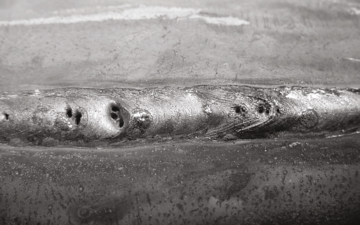What is Porosity in Welding: Finest Practices for Preventing Porous Welds
What is Porosity in Welding: Finest Practices for Preventing Porous Welds
Blog Article
The Science Behind Porosity: A Comprehensive Overview for Welders and Fabricators
Recognizing the complex mechanisms behind porosity in welding is important for welders and fabricators aiming for impeccable craftsmanship. From the make-up of the base products to the details of the welding procedure itself, a multitude of variables conspire to either exacerbate or minimize the visibility of porosity.
Comprehending Porosity in Welding
FIRST SENTENCE:
Exam of porosity in welding discloses vital insights into the stability and high quality of the weld joint. Porosity, defined by the existence of dental caries or voids within the weld metal, is a typical worry in welding processes. These voids, if not effectively dealt with, can compromise the architectural honesty and mechanical residential or commercial properties of the weld, bring about potential failures in the finished item.

To spot and measure porosity, non-destructive screening techniques such as ultrasonic testing or X-ray inspection are often employed. These strategies permit the identification of interior defects without endangering the stability of the weld. By assessing the size, shape, and distribution of porosity within a weld, welders can make educated decisions to improve their welding procedures and accomplish sounder weld joints.

Aspects Affecting Porosity Development
The event of porosity in welding is affected by a myriad of aspects, ranging from gas shielding performance to the intricacies of welding specification setups. One important element adding to porosity formation is insufficient gas protecting. When the protecting gas, commonly argon or CO2, is not properly covering the weld swimming pool, atmospheric gases like oxygen and nitrogen can infect the molten metal, bring about porosity. Additionally, the sanitation of the base products plays a considerable role. Impurities such as rust, oil, or dampness can vaporize during welding, creating gas pockets within the weld. Welding criteria, consisting of voltage, current, take a trip speed, and electrode type, additionally effect porosity formation. Making use of incorrect settings can produce too much spatter or heat input, which subsequently can result in porosity. In addition, the welding technique employed, such as gas steel arc welding (GMAW) or shielded steel arc welding (SMAW), can affect porosity formation due to variants in warm distribution and gas insurance coverage. Recognizing and managing these factors are crucial for reducing porosity in welding procedures.
Results of Porosity on Weld High Quality
Porosity development dramatically endangers the architectural stability and mechanical residential properties of welded joints. When porosity exists in a weld, it develops gaps or dental caries within the product, reducing the overall toughness of the joint. These gaps work as stress and anxiety focus points, making the weld extra at risk Get More Information to splitting and failure under lots. The visibility of porosity additionally damages the weld's resistance to rust, as the trapped air or gases within deep spaces can react with the surrounding setting, bring about destruction gradually. Additionally, porosity can hinder the weld's capability to stand up to pressure or effect, additional jeopardizing the total top quality and reliability of the welded framework. In important applications such as aerospace, vehicle, or official site architectural building and constructions, where safety and security and toughness are vital, the detrimental effects of porosity on weld top quality can have severe effects, emphasizing the importance of decreasing porosity via correct welding techniques and treatments.
Strategies to Lessen Porosity
To enhance the high quality of bonded joints and make sure architectural integrity, welders and producers use particular strategies aimed at lowering the development of voids and tooth cavities within the product throughout the welding process. One efficient approach to lessen porosity is to make certain proper product preparation. This includes extensive cleaning of the base steel to get rid of any pollutants such as oil, oil, or moisture that could contribute to porosity formation. Furthermore, utilizing the ideal welding criteria, such as the correct voltage, current, and take a trip rate, is essential in stopping porosity. Preserving a regular arc size and angle throughout welding also assists lower the likelihood of porosity.

Moreover, choosing the best shielding gas and maintaining correct gas flow prices are crucial in decreasing porosity. Making use of the proper welding technique, such as back-stepping or employing a weaving activity, can also help distribute heat equally and lower the possibilities of porosity development. Making sure proper air flow in the welding setting to get rid of any kind of potential resources of contamination is crucial for achieving porosity-free welds. By applying these techniques, welders can efficiently lessen porosity and create high-quality welded joints.

Advanced Solutions for Porosity Control
Applying advanced modern technologies and cutting-edge techniques plays a crucial role in attaining remarkable control over porosity in welding processes. Furthermore, utilizing advanced welding strategies such as pulsed MIG welding or modified environment welding can also aid mitigate porosity problems.
An additional innovative option entails making use of sophisticated welding devices. Using devices with built-in features like waveform control and advanced power sources can improve weld quality and decrease porosity dangers. The application of automated welding systems with specific control over specifications can substantially lessen porosity flaws.
Moreover, incorporating innovative surveillance and examination modern technologies such as real-time X-ray imaging or automated ultrasonic testing can aid in spotting porosity early in the welding procedure, enabling immediate corrective activities. Overall, incorporating these innovative solutions can substantially boost porosity control and improve the overall quality of bonded elements.
Final Thought
To conclude, recognizing the science behind porosity in welding is essential for welders and makers to a fantastic read create high-quality welds. By recognizing the aspects influencing porosity development and applying methods to reduce it, welders can improve the overall weld top quality. Advanced services for porosity control can further boost the welding procedure and ensure a solid and dependable weld. It is important for welders to continually enlighten themselves on porosity and execute best methods to attain optimum results.
Report this page